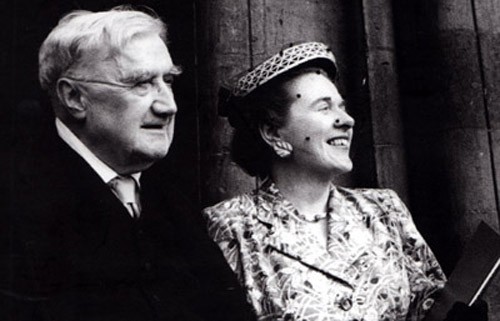The 1945 film A Song to Remember offers a romanticised (some would say bastardised) portrayal of the life of Polish composer and pianist Frédéric Chopin, and, as of early 2025, it’s available for free on YouTube.
A Song To Remember
But there are lots of movies out there, so before you sink two hours into this lush Technicolor extravaganza, here are some observations to help you decide whether you’ll enjoy it or not.
The colors are pretty!
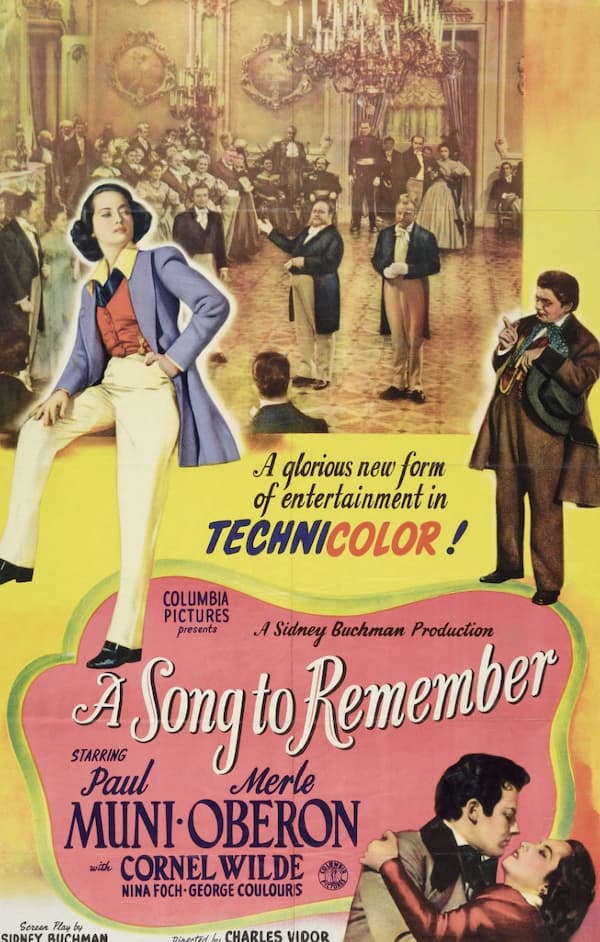
To fully appreciate the aesthetic of A Song to Remember, it’s necessary to briefly delve into Hollywood history.
Throughout the 1930s, studios experimented with using Technicolor film. In 1935, Becky Sharp became the first feature film photographed in three-strip Technicolor. Snow White and the Seven Dwarves, the highest-grossing film of 1938, also famously employed Technicolor.
However, the downside to Technicolor was that it required huge budgets, bulky equipment, and sweltering lights. Because of these drawbacks, even well into the 1940s, color films remained noteworthy.
A Song to Remember, released in January 1945, was one of the first movies about classical music shot in Technicolor.
A Song to Remember
The costume and set design take full advantage of the new technology…to the point where modern eyes might feel overwhelmed. (George Sand’s costumes are especially astonishing on this front.)
The music is great!
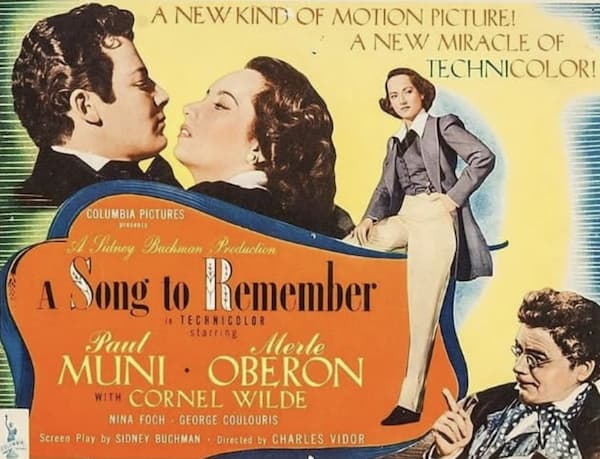
The soundtrack is inspired by Chopin’s music.
The man who created the arrangements was Miklós Rózsa, an incredible composer born in Budapest in 1907.
He came to Hollywood to escape World War II, a few years before he was hired to score this film.
Over the course of his career, he would compose nearly a hundred film scores.
This was clearly a film made in wartime, and that’s fascinating.
When figures from classical music history appear in films, their biographies are almost always rewritten to suit Hollywood executives’ priorities and reflect the wider culture. A Song to Remember is no exception.
As this film was being made in 1944, America was deep in the throes of World War II. America’s number-one foe was Adolf Hitler, who had, of course, recently launched an invasion of Poland.
It makes sense then that this wartime film would center around Chopin’s Polish identity and his love for his Polish countrymen, as well as his willingness to sacrifice his health and even life to support his homeland. The unspoken message throughout is: Chopin was a hero for sacrificing for a war effort, and so are you!
Sometimes this subtext works within the context of the story. One of the most effective scenes of the film happens when Chopin begins playing his Revolutionary Etude. The camera then pulls back to reveal he’s in a room of bored, oblivious aristocrats allied with oppressors, all oblivious to the message he’s sending through his music.
Other moments, however, are less emotionally convincing. In the end, A Song to Remember turned the life of Chopin into Allied propaganda, even as the script veered away from the more complex historical reality of Chopin’s life. As a result, the film’s wartime messaging can come across as heavy-handed today.
The filmmakers make some bizarre storytelling choices.
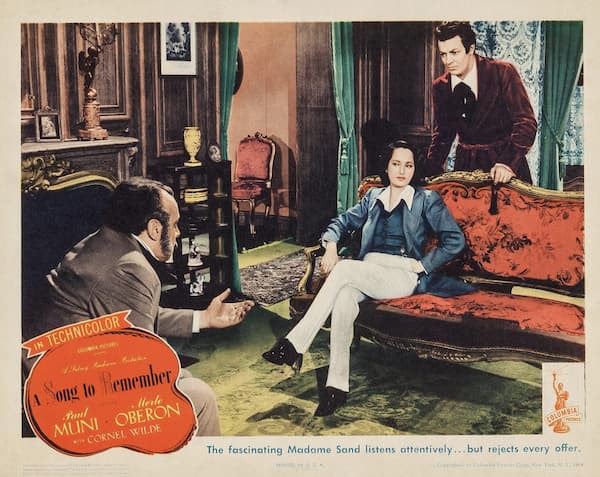
Chopin’s Polish composition teacher, Józef Elsner, appears as a main character in the film. Elsner travels to Paris with Chopin as his socially inept companion.
Elsner starts out as comic relief – a cliched absentminded professor – but in the second half of the film, viewers are expected to take him seriously. That tonal whiplash is rough to navigate as a viewer.
In real life, when Chopin went to Paris, he did so with his best friend Tytus Woyciechowski and left Elsner behind.
Maybe Elsner was meant to be a kind of composite character, or a stand-in for the spirit of the people of Poland. But even so, the way he’s used is just odd.
The filmmakers’ treatment of Chopin’s terminal illness (tuberculosis) is also strange to modern eyes. Even as the characters are continually fretting over how ill Chopin is, he never looks particularly sick. He coughs a few drops of blood on the piano once, then looks pale in the film’s final montage, and that’s about it.
George Sand is done dirty in this adaptation.
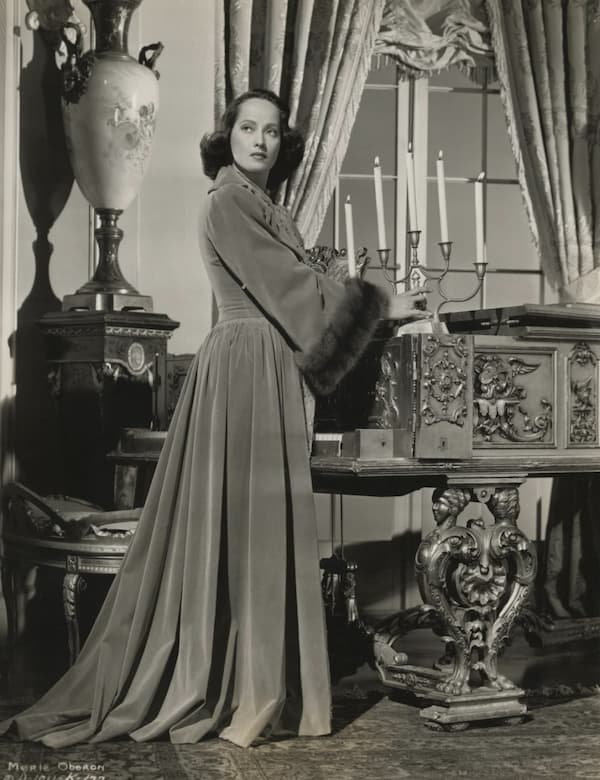
A Song to Remember – George Sand
Chopin’s love interest, George Sand, played here by the great English actress Merle Oberon, was the most surprising part of the movie.
The filmmakers introduce her wearing her masculine attire. (In fact, the bumbling Professor Elsner doesn’t even recognize that she’s a woman.)
However, after that, she wears feminine clothing exclusively, save for the occasional masculine accessory, such as the odd top hat or cane.
It was certainly quite the choice to depict her famous male attire, show her wearing it once, and then dress her solely in Technicolor-friendly gowns thereafter.
The script also downplays the importance of Sand’s own career and fame. In reality, during her lifetime, Sand was one of the most famous writers in Europe. She was also deeply sympathetic to liberal and revolutionary causes, especially during the time she was with Chopin.
In the film, she expresses disgust at hearing Chopin’s “Heroic” polonaise. Meanwhile, in real life, Sand was actually a huge fan of the piece, and even bestowed the work’s “heroic” sobriquet. In 1841, she wrote to Chopin, “The inspiration! The force! The vigour! There is no doubt that such a spirit must be present in the French Revolution. From now on, this polonaise should be a symbol, a heroic symbol.”
All that said, here’s a moment for the melodrama hall of fame: Sand’s breakup speech to Chopin, delivered after he chooses to go on tour to raise money for Poland, a self-sacrificing act that will undoubtedly kill him:
You think this is strength, Frederic, and high purpose? I call it pulling weakness! Give your life into other people’s hands, and the character you have left is what those people graciously let you have. No one knows this human jungle better than I. No one ever fought more bitterly to survive in it. To have had some talent and ambition, and to be a woman, in masculine eyes, something slightly better than a head of cattle, I buried the woman, wrote behind a man’s name, wore trousers to remind them I was their equal. Yes! And was fully as moral as they were, no more, no less. Maybe you think it didn’t cost a woman something to do it. Year after year, in the face of contempt and slander. But there was the reward to remember. I ruled my own life, and what I set out to do, I did! You followed that example and became great! And now, if a thousand weaklings came to me to draw me into their hopeless causes, to ask me to lift their misbegotten lives at the waste of my own, I’d see every last one of them rotting first! That would be strength and dignity!
The New York Times reported that during the premiere, the audience erupted into applause after this monologue. It makes one wish that Oberon’s Sand would have been the film’s protagonist.
Honestly, historical women in general are given short shrift here.
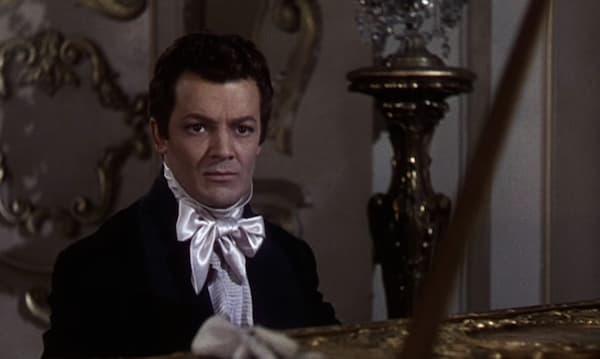
A Song to Remember – Frédéric Chopin
At the beginning of the film, we are introduced to Chopin’s sister (presumably Ludwika Jędrzejewicz), who is being fitted for a dress to go watch her brother perform. We don’t see her again.
It’s never mentioned that in real life, Ludwika was a pianist and composer herself, and one of Chopin’s closest confidants. She spent months taking care of him in his final illness and, after he died, organising his papers.
It’s also worth pointing out that Liszt plays at Chopin’s deathbed, instead of the woman who it is believed actually did: countess and Chopin student Delfina Potocka.
The important role that the women in Chopin’s life played is continually downplayed.
As heavy-handed as the film can be, it does raise timely questions about what roles musicians should play in politics.
The film idolises artists who become involved in political causes, and sharply criticises those who don’t.
This theme echoes modern conversations that classical musicians continue to have today. What responsibilities do they have when it comes to speaking out against oppression or rising totalitarianism?
It’s interesting to realise we’re still asking these same questions eighty years after this film was released. The fact that we are suggests that we’ll be grappling with these issues for a long time to come.
Final Thoughts
Unless you’re a huge fan of Chopin or World War II era Technicolor films, I think you can skip A Song to Remember. There are other more entertaining – and more accurate – depictions of the life of Chopin and his contemporaries on film.
On the other hand, if colorful and melodramatic composer biopics are your cup of tea, or would like to imagine Chopin resisting the Nazis in spirit, there’s a lot here to enjoy. Let us know what you think.
For more of the best in classical music, sign up for our E-Newsletter

